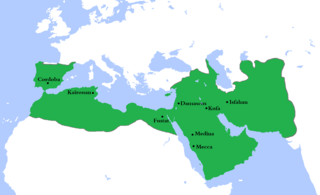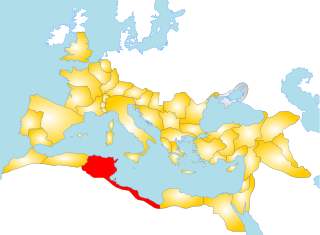Ṭāriq ibn Ziyād was a Muslim commander who led the Islamic Umayyad conquest of Visigothic Hispania in 711–718 A.D. Under the orders of the Umayyad Caliph Al-Walid I he led a large army and crossed the Strait of Gibraltar from the North African coast, consolidating his troops at what is today known as the Rock of Gibraltar. The name "Gibraltar" is the Spanish derivation of the Arabic name Jabal Ṭāriq, meaning "mountain of Ṭāriq", which is named after him.

Sulayman ibn Abd al-Malik was the seventh Umayyad caliph, ruling from 715 until his death. Prior to his accession, he served as the governor of Palestine, where he developed close ties with the tribo-political faction of the Yaman and founded the city of Ramla. He succeeded his brother, al-Walid I, and dismissed nearly all of his predecessors' governors and generals, many of whom had led the war efforts which brought the caliphate to its greatest territorial extent. Though expansion under Sulayman largely stopped, partly due to increasing pushback from local forces along the frontiers, his governor over Iraq and Khurasan, Yazid ibn al-Muhallab, conquered the southern Caspian coast in 716. Moreover, under Sulayman, the war with the Byzantine Empire intensified. He directed the campaign from his northern Syrian headquarters in Dabiq, while his half-brother Maslama held the overall field command. Their offensive was one of the deepest launched by the Arabs against Byzantium, culminating in the sieges of Constantinople in the summers of 717 and 718, both ending in the Arabs' defeat. Sulayman died in Dabiq in between the two sieges. On his deathbed and under the counsel of his chief adviser, Raja ibn Haywah, he made the unconventional choice of nominating his cousin, Umar II, as his successor, rather than one of his sons or brothers.

Umar ibn Abd al-Aziz or Omar ibn Abd al-Aziz was an Umayyad caliph who ruled from 717 to 720. He was also a cousin of the former caliph, being the son of Abd al-Malik's younger brother, Abd al-Aziz. He was also a matrilineal great-grandson of the second caliph Umar ibn Al-Khattab.

Musa bin Nusayr served as a governor and general under the Umayyad caliph Al-Walid I. He ruled over the Muslim provinces of North Africa (Ifriqiya), and directed the Islamic conquest of the Visigothic Kingdom in Hispania.
North Africa is a relatively thin strip of land between the Sahara desert and the Mediterranean, stretching from Moroccan Atlantic coast to Egypt. Currently, the region comprises seven countries or territories, from west to east: Morocco, Western Sahara, Algeria, Tunisia, Libya and Egypt. The region has been influenced by many diverse cultures. The development of sea travel firmly brought the region into the Mediterranean world, especially during the classical period. In the 1st millennium AD, the Sahara became an equally important area for trade as camel caravans brought goods and people from the south. The region also has a small but crucial land link to the Middle East, and that area has also played a key role in the history of North Africa.
ʾAḥmad ibn Yaḥyā al-Balādhurī was a 9th-century Muslim historian. One of the eminent Middle Eastern historians of his age, he spent most of his life in Baghdad and enjoyed great influence at the court of the caliph al-Mutawakkil. He traveled in Syria and Iraq, compiling information for his major works.

The Muslim conquest of the Maghreb continued the century of rapid Arab Early Muslim conquests following the death of Muhammad in 632 AD and into the Byzantine-controlled territories of Northern Africa. In a series of three stages, the conquest of the Maghreb commenced in 647 and concluded in 709 with the "Byzantine" Roman Empire losing its last remaining strongholds to the then-Umayyad Caliphate.
Abu al-Muhajir Dinar, amir of Ifriqiya under the Umayyads.
Ubayd Allah ibn al-Habhab al-Mawsili was an important Umayyad official in Egypt from 724 to 734, and subsequently Umayyad governor of Kairouan, Ifriqiya from 734 to 741. It was under his rule that the Great Berber Revolt broke out in the Maghreb and al-Andalus.
Ismail ibn Abd Allah ibn Abi al-Muhajir (?-?) was an Umayyad governor of Ifriqiya from 718 to 720.
ʿAbdallāh ibn ʿAbd al-Malik ibn Marwān was an Umayyad prince, the son of Caliph Abd al-Malik ibn Marwan, a general and governor of Egypt.
Salih ibn Ali ibn Abdallah ibn al-Abbas was a member of the Abbasid dynasty who served as general and governor in Syria and Egypt.
ʿAbd al-ʿAzīz ibn Marwān was the Umayyad governor and de facto viceroy of Egypt between 685 and his death. He was appointed by his father, Caliph Marwan I. Abd al-Aziz's reign was marked by stability and prosperity, partly due to his close relations and reliance on the Arab military settlers of Fustat. Under his direction and supervision, an army led by Musa ibn Nusayr completed the Muslim conquest of North Africa. He was removed from the line of succession to the caliphal throne and, in any case, died before his brother, Caliph Abd al-Malik. However, one of Abd al-Aziz's sons, Umar II, would become caliph in 717–720.
The Battle of Mamma took place in 690 between the Arab Muslim forces of the Umayyad Caliphate and the Berbers led by Caecilius of Kingdom of Altava.
Abū Marwān Bishr ibn Marwān ibn al-Ḥakam was an Umayyad prince and governor of Iraq during the reign of his brother, Caliph Abd al-Malik. Bishr fought at Marj Rahit with his father, Caliph Marwan I. The latter later posted Bishr to Egypt to keep his brother Abd al-Aziz company. In 690/91, Bishr was made governor of Kufa and about one year later, Basra was added to his governorship, giving him full control of Iraq.
Saʿīd ibn ʿAbd al-Malik ibn Marwān ibn al-Ḥakam, also known as Saʿīd al-Khayr, was an Umayyad prince and governor. He served as governor of Mosul for a undetermined period under his father Caliph Abd al-Malik and was responsible for a number of building and infrastructural works. He also played a role in the construction of the Dome of the Rock in Jerusalem. He was later granted property in Mosul's vicinity by Caliph al-Walid I or Caliph Umar ibn Abd al-Aziz, which he turned into an agricultural tract with a canal. He later led a summer campaign against the Byzantines in Anatolia. During the brief rule of Caliph al-Walid II, Sa'id served as governor of Palestine, but was expelled by rebels in the district after al-Walid's death. Sa'id was ultimately killed during the massacre of the Umayyad family near Ramla after the Abbasid victory over the dynasty in 750.












